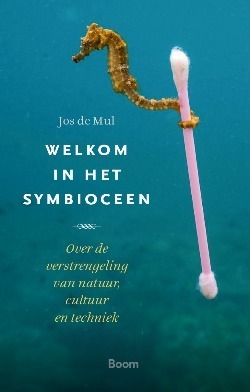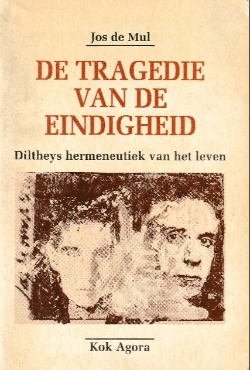Jos de Mul. The Tragedy of Finitude. Dilthey's Hermeneutics of Life. Analecta Hermeneutica, Vol. 1, no. 1 (2009), 248-251.
The publication of substantial parts of Wilhelm Dilthey’s philosophical legacy in volumes 17 (1977), 19 (1982), 20 (1990), 21 (1997), and 23 (2000) of his Gesammelte Schriften necessitates a thorough reinterpretation of his entire philosophy. The Tragedy of Finitude. Dilthey''s Hermeneutics of Life aims to contribute to such a reinterpretation by reconstructing the ontological foundation of Dilthey’s hermeneutics of life.
The analytical presupposition is that Dilthey’s ontology is a continuation and radicalization of Kant’s transcendental enterprise. He initially regarded his project, for which he had chosen the Kantian title Kritik der historischen Vernunft, as a complement of Kant’s transcendental critique of pure reason. He proposed that the validity of Kant’s critique of theoretical reason, i.e., analysis, justification and determination of its limits, is restricted to the natural sciences (Naturwissenschaften), while his own critique of historical reason aims at a transcendental investigation concerning the conditions of the possibility of historical knowledge in the human sciences (Geisteswissenschaften). Gradually, however, Dilthey’s project turns out to be a fundamental transformation of two ontological presuppositions of Kant’s transcendental investigation. In the first place, he understands categories to be categories of life (Lebenskategorien) rather than formal categories: his transcendental self-reflection aims at an explication of the fundamental structures of the primordial nexus of life in which man is always already situated and which precedes the theoretical distinction between subject and object. In this context, Dilthey also criticizes the intellectualism of Kant’s critique: the life-world is not an object of sheer intellectual representation, but, rather, a reality which is immediately given [to us] in the interplay of thinking, willing, and feeling. In the second place, Dilthey rejects the Kantian presupposition that the a priori structures of experience are universal and timeless, claiming instead that they are characterized by historical development. With this emphasis on the historicity of the categories of life, Dilthey radicalizes two themes which already play an important role in Kant’s transcendental enterprise, namely, the finiteness and contingency of human life. The profound topicality of Dilthey’s transcendental-historical philosophy is given by the fact that these two themes belong to the central preoccupations of contemporary philosophical concern.
This study, in which sytematic analysis and historical investigation are in constant interplay, consists of three Parts. In Part I, a sketch is given of the horizon against which Dilthey developed his Kritik der historischen Vernunft. Part II elaborates a systematic reconstruction of Dilthey’s ontology of life, and, in Part III, his hermeneutic ontology is confronted with the works of Heidegger, Gadamer, and Derrida, and its relevance for current philosophical discussion is evaluated.
In Chapter 1 of Part I both a sketch of Dilthey’s life and works and an overview of relevant secondary literature are provided. Special attention is paid to the fragmentary, unfinished and often ambiguous character of his Kritik, as well as to the problems which this poses for interpretation. Chapter 2 examines and discusses the ontological presuppositions of Kant’s transcendental philosophy, while in Chapter 3 a sketch is provided of the historicization of world-view in nineteenth-century philosophy. This latter sketch focuses on those movements and thinkers which incited Dilthey to his historicization of transcendental philosophy, namely, the Idealist philosophy of Fichte and Hegel, the Positivism of Comte and Mill, the hermeneutics of Schleiermacher, and the historicist school of Ranke and Droysen.
The reconstruction proper of Dilthey’s ontology of human life begins with Chapter 4, the first chapter of Part II, and consists of a detailed analysis of the two fundamental revisions of Kant’s transcendental criticism, elaborated in the Einleitung in die Geisteswissenschaften (1883) and related texts from Dilthey’s legacy, which were mentioned above. Chapter 4 concludes with a discussion of Dilthey’s (implicit) reinterpretation of the concept of the ‘transcendental’: the subject of his transcendental-historical self-reflection is not only the historicity of human life, but, also, the different transcendental structures of experience which develop in the course of history. According to Dilthey, therefore, transcendental analysis and empirical investigations in the human sciences are interdependent.
In Chapter 5, the focus is on the ontology of life as Dilthey developed it in his descriptive psychological writings Ideen über eine beschreibende und zergliedernde Psychologie (1894), Beiträge zum Studium der Individualität (1895/1896), and a number of related texts from the legacy. The Chapter opens with an examination of the relationships between descriptive psychology, explanatory psychology, and epistemology. The aim of descriptive psychology is a phenomenological description of the structure and development, as given in inner experience (Innere Erfahrung or Erlebnis), of the nexus of life (Lebenszusammenhang). In a certain sense, Dilthey’s descriptive psychology foreshadows Piaget’s genetic epistemology, but, whereas Piaget tends to regard the pattern of development as invariant, Dilthey emphasizes the individuality of that pattern. Moreover, unlike Piaget, Dilthey comprehends the nexus of life not primarily from a functionalist viewpoint, but, hermeneutically, as a meaningful totality: understanding the expressions and actions of a person means relating them to an unique developmental pattern. Dilthey’s model of human development may be called narrative because, in it, life is not only (metaphorically) conceived of as a meaningful story, but, also, it comprehends the description of human experience as a narrative activity: the explication of implicit meaning always involves an act of imagination.
Chapter 6 provides a critical examination of Dilthey’s descriptive psychology, linking up with the critique from some of his contemporaries. The critique of the explanatory psychologist Ebbinghaus partly misses its goal because it misconceives Dilthey’s descriptive psychology as a kind of empirical research, but it does, rightly, point to the problems raised by his appeal to introspection. The critique from the neo-Kantians Windelband and Rickert forces Dilthey to specify his demarcation of natural and human sciences: unlike the neo-Kantians, he finds that these differences are not due to different methods, but, rather, that they are grounded in different ontologies. According to Dilthey, outer and inner experience constitute different domains of experience. On this issue, Husserl sides with Dilthey, regarding his descriptive psychology as a brilliant, though still confused, foreshadowing of his own (i.e., Husserl’s) phenomenological method. Although Husserl’s phenomenological terminology enables Dilthey to clarify his own position, it becomes clear that the latter’s radical emphasis on the historical character of the nexus of life is not at all compatible with the former’s “Kantian” belief in universal and timeless meanings. Nietzsche, like Ebbinghaus, directs his critique to Dilthey’s appeal to introspection and emphasizes, radically, the historical and interpretative character of all understanding. The critiques of his contemporaries force Dilthey to re-evaluate the whole of his transcendental-historical project. In this present study, contrary to interpretations which suppose that there is a radical shift from Dilthey’s earlier descriptive psychology to his post-1900 hermeneutics writings, the thesis is defended that those later writings, rather than a completely new beginning, have to be considered as a hermeneutic reinterpretation of his descriptive psychology.
In Chapter 7, the reinterpretation thesis is elucidated by a detailed analysis of Dilthey’s later hermeneutic writings. In these writings, he develops his famous triad of inner experience (Erlebnis), expression (Ausdruck), and understanding (Verstehen), now admitting that the range of introspection is very restricted and that understanding of ourselves and others mainly occurs via the understanding of the expressions of inner experience. Using concepts from Husserl’s Logische Untersuchungen, but sticking to his own historical approach, Dilthey elaborates, in Der Aufbau der geschichtlichen Welt in den Geisteswissenschaften and, from the legacy, Entwürfe zur Kritik der historischen Vernunft, an elucidating and differentiated, though fragmented, analysis of the synchronic and diachronic structure of inner experience, of the different types of expressions, and of the different forms of understanding. For Dilthey, understanding aims not only at a reconstruction of the inner experience and intentions of persons, but, also, at the independent meaning of the expressions. Although he maintains that the interpretative human sciences aim at objectivity, he sharply distinguishes this objectivity from that which is aimed at in the natural sciences: in the human sciences, objectivity may not be identified with general validity. In interpretation, because the specific individual horizon of the interpreter is constitutive [for that interpretation], the term objectivity refers to the inter-subjective accessibility of the object of interpretation.
The second half of Chapter 7 deals with Dilthey’s theory of world-views (Weltanschauungslehre). As in the case of Kant, his transcendental critique not only has a positive part, offering a justification of the possibility of understanding, but, also, a negative part which deals with the limitations of understanding. Also, like Kant, he criticizes the pretension of traditional metaphysic to attain an absolute knowledge of reality. However, according to Dilthey modern philosophers like Kant and Hegel remain, in a way, victims of the metaphysical tradition to the extent that they presuppose a timeless transcendental subject. On the other hand, he follows Kant in his view that finite man relies on metaphysics in order to orientate himself in the world. Dilthey distinguishes three different types of world-view, based respectively on a theoretical, a practical, and an aesthetic approach of life and word.
In Chapter 8, opening Part III, after a short discussion of the critique of Rickert and Husserl of the philosophy of world-views, Dilthey’s hermeneutics of life is confronted with Heidegger, Gadamer, and Derrida. After showing what Heidegger’s analytic of Dasein owes to Dilthey, his critique that Dilthey is a victim of ontological indifference is discussed at length. It is argued that ontic and ontological discussions do, indeed, have to be distinguished more properly than Dilthey did, but that they cannot be separated as completely as Heidegger, especially after his famous reversal, attempts to do. It is also argued that Heidegger’s conception of Being and of the ontological difference is inevitably no less ambiguous than Dilthey’s key-concept, life. Gadamer, in his influential Wahrheit und Methode, repeating the critique of Heidegger, rejects Dilthey’s hermeneutics because he regards it as a plea for a sterile, objectivist reconstruction, which does no justice to the dialogical character of understanding: instead of a broadening of our horizons, his constructivist hermeneutic advocates a fusion of horizons. Although it is admitted that Gadamer directs our attention to an important dimension of understanding that Dilthey has not elaborated in detail, it is argued that reconstruction plays an important role as well, even within a fusion of horizons. Moreover, it is argued that Gadamer’s notion of the ‘fusion of horizons’ bares a strong Hegelian mark. The comparison with Derrida’s deconstructive dispersion of horizons makes clear that he and Dilthey share a profound awareness of the finiteness of human understanding. From Dilthey’s viewpoint, critical remarks are made concerning Derrida’s denial of the referential function of signs, his conception of the undecidability of meaning, and the role of individuality in interpretation.
In Chapter 9, with the help of the fundamental concepts of finiteness,contingency, and ambivalence, the results of the study are summarized and some further conclusions are drawn. It is argued that man relies on hermeneutics because it is an answer to the finiteness, the contingency, and the ambivalence of human life: together with art-forms such as the novel, narrative human studies are best fit to deal with these fundamental characteristics of human life and to create meaning in complex and enigmatic life. Linking up with Dilthey’s philosophy of world-views, the thesis is defended that theoretical reconstruction, as represented by Dilthey-an hermeneutics, practical construction, as represented by Gadamer’s philosophical hermeneutics, and aesthetic deconstruction of meaning, as represented by Derrida’s deconstructionism, although incompatible on a theoretical level, are simultaneously the lived moments of modern man’s experience of finite existence.









